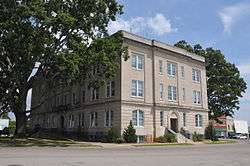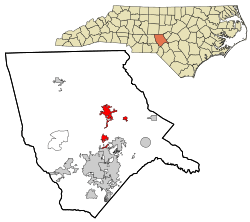Carthage, North Carolina
| Carthage, North Carolina | |
|---|---|
| Town | |
 Moore County Courthouse in Carthage | |
 Location in Moore County and the state of North Carolina. | |
| Coordinates: 35°7′54.3″N 79°25′37.3″W / 35.131750°N 79.427028°WCoordinates: 35°7′54.3″N 79°25′37.3″W / 35.131750°N 79.427028°W | |
| Country | United States |
| State | North Carolina |
| County | Moore |
| Government | |
| • Type | council-manager |
| Elevation | 617 ft (188 m) |
| Population (2010) | |
| • Total | 2,438 |
| • Estimate (2016)[1] | 2,438 |
| Time zone | UTC-5 (Eastern (EST)) |
| • Summer (DST) | UTC-4 (EDT) |
| ZIP code | 28327 |
| Area code(s) | 910 |
| FIPS code | 37-00160[2] |
| GNIS feature ID | 1018757[3] |
| Website | www.townofcarthage.org |
Carthage is a town in Moore County, North Carolina, United States. The population was 2,205 at the 2010 Census. It is the county seat of Moore County.[4]
Geography
Carthage is located at 35°19′46″N 79°24′31″W / 35.32944°N 79.40861°W (35.329441, -79.408475).[5]
According to the United States Census Bureau, the town has a total area of 5.9 square miles (15 km2), of which, 5.8 square miles (15 km2) of it is land and 0.04 square miles (0.10 km2) of it (0.68%) is water.
Demographics
| Historical population | |||
|---|---|---|---|
| Census | Pop. | %± | |
| 1880 | 366 | — | |
| 1890 | 485 | 32.5% | |
| 1900 | 605 | 24.7% | |
| 1910 | 863 | 42.6% | |
| 1920 | 962 | 11.5% | |
| 1930 | 1,129 | 17.4% | |
| 1940 | 1,381 | 22.3% | |
| 1950 | 1,194 | −13.5% | |
| 1960 | 1,190 | −0.3% | |
| 1970 | 1,034 | −13.1% | |
| 1980 | 925 | −10.5% | |
| 1990 | 976 | 5.5% | |
| 2000 | 1,871 | 91.7% | |
| 2010 | 2,205 | 17.9% | |
| Est. 2016 | 2,438 | [1] | 10.6% |
| U.S. Decennial Census[6] | |||
As of the census of 2010, there were 2,205 people, 653 households, and 440 families residing in the town. The racial makeup of the town was 70.0% White, 23.9% African American, 0.7% Native American, 0.7% Asian, 1.3% from other races, and 2.7% from two or more races. Hispanic or Latino of any race were 3.3% of the population.
There were 934 households out of which 26.9% had children under the age of 18 living with them, 39.0% were married couples living together, 13.4% had a female householder with no husband present, and 42% were non-families. 30.4% of all households had members 18 years or younger, and 36.4% had someone living alone who was 65 years of age or older. The average household size was 2.24 and the average family size was 2.99 persons.
The median income for a household in the town was $36,842, and the median age was 38.1 years. The median poverty rate was 17.6%, and the median property value was $141,600.
History

The town was the home of the Tyson Buggy Company, a predominant cart and buggy manufacturer in the late 1800s. A common local story is that after the closing of the Tyson Buggy Company, Henry Ford was interested in buying the old plant and converting it into a car assembly line. According to the legend, the owners refused to let Ford buy the plant. He moved on and built his first plant in Detroit, making it the center of auto manufacturing. This story is often repeated despite a lack of evidence, and it does not fit runs contrary to the life of Ford, who was born and raised in Detroit and started his businesses there. A few years after being closed, the former Tyson Buggy plant burned down.
Another common local story is that the town was originally selected as the site for the University of North Carolina. But supposedly city leaders did not want the university built there. City leaders purportedly told the State that Carthage was on too steep of a hill for locomotives to climb and that access to the University would be limited if built there. This often-repeated story does not account for the fact that locomotives were not invented until two decades after the university had been built in Chapel Hill.
The town has an annual event in spring called the Buggy Festival. This event is used to showcase the history of the town and feature music, hot rods, old tractors, old buggies made by the Tyson Buggy Company, and crafts from potteries in the surrounding areas. This event is held in the town square around the Old Court House, recognized as an historic landmark.
The J.C. Black House, Daniel Blue House, Bruce-Dowd-Kennedy House, Carthage Historic District, Alexander Kelly House, and Moore County Courthouse are listed on the National Register of Historic Places.[7]
2009 shooting
On March 29, 2009, a man named Robert Stewart shot and killed eight people and wounded two others at the Pinelake Health and Rehab Center of Carthage.[8] Seven of the victims were elderly patients, with ages ranging from 75 to 98 years old. The eighth was a 39-year-old registered nurse who worked at the facility. The gunman, Robert Stewart, traded gunfire with a local police officer, wounding him in the leg before he himself was wounded and taken to a nearby medical facility.[9] Authorities identified the victims as Pinelake residents Tessie Garner, 75; Lillian Dunn, 89; Jesse Musser, 88; Bessie Hedrick, 78; John Goldston, 78; Margaret Johnson, 89; Louise DeKler, 98; and nurse Jerry Avant, 39.
References
- 1 2 "Population and Housing Unit Estimates". Retrieved June 9, 2017.
- ↑ "American FactFinder". United States Census Bureau. Archived from the original on 2013-09-11. Retrieved 2008-01-31.
- ↑ "US Board on Geographic Names". United States Geological Survey. 2007-10-25. Retrieved 2008-01-31.
- ↑ "Find a County". National Association of Counties. Archived from the original on 2011-05-31. Retrieved 2011-06-07.
- ↑ "US Gazetteer files: 2010, 2000, and 1990". United States Census Bureau. 2011-02-12. Retrieved 2011-04-23.
- ↑ "Census of Population and Housing". Census.gov. Archived from the original on April 22, 2013. Retrieved June 4, 2015.
- ↑ National Park Service (2010-07-09). "National Register Information System". National Register of Historic Places. National Park Service.
- ↑ Gunman kills six at US care home BBC - Sunday, 29 March 2009
- ↑ Eight dead in Carthage nursing-home shooting - WRAL.com, March 29, 2009.